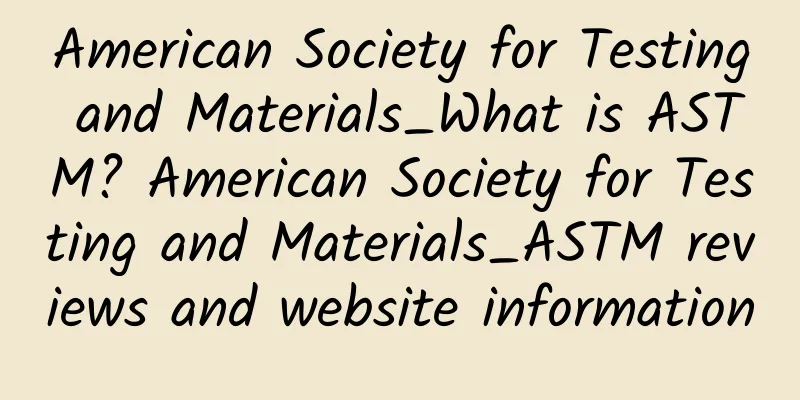American Society for Testing and Materials_What is ASTM website? The American Society for Testing and Materials (ASTM International, referred to as ASTM) is an international standardization organization, founded in 1898, headquartered in West Conshohocken, Pennsylvania, USA, mainly formulates and publishes voluntary consensus technical standards for materials, products, systems and services.
Website: www.astm.org
```html ASTM International (ASTM) is an international standardization organization founded in 1898 and headquartered in West Conshohocken, Pennsylvania, USA. ASTM's main mission is to develop and publish voluntary consensus technical standards for materials, products, systems and services. These standards are widely adopted around the world and play a vital role in standardization, quality control and safety in all walks of life. The history of ASTM can be traced back to the late 19th century, when the U.S. industry was developing rapidly and urgently needed a set of unified standards to regulate the production and use of materials and products. In 1898, a group of engineers and scientists founded the predecessor of ASTM, the American Society for Testing Materials, in Pennsylvania, with the aim of ensuring the quality and reliability of materials by setting standards. Over time, ASTM's mission and influence have continued to expand. Not only has it gained widespread recognition in the United States, it has also gradually become one of the leaders in global standardization. In 2001, ASTM officially changed its name to ASTM International to reflect its international vision and global influence. ASTM Organizational Structure ASTM International's organizational structure is very rigorous and efficient, mainly composed of the following parts: - Board of Directors : Responsible for setting ASTM's strategic direction and policies.
- Technical Committees : Responsible for the formulation and revision of specific standards, covering various industries and fields.
- Task Groups : Established under the Technical Committee, focusing on research and standard setting for specific technical issues.
- Members : ASTM members come from companies, academic institutions, government agencies and non-profit organizations around the world, and they jointly participate in the formulation and promotion of standards.
ASTM members are divided into individual members and group members. Individual members are usually industry experts, scholars or engineers who provide professional knowledge and experience for the formulation of standards by participating in the work of technical committees and standard-setting groups. Group members include enterprises, academic institutions and other organizations. By joining ASTM, they can keep abreast of the latest industry standards, participate in the formulation and revision of standards, and thus ensure the competitiveness of their own products and services. ASTM Standardization Process ASTM's standardization process is very transparent and democratic, ensuring that all stakeholders can participate. The development of standards usually includes the following steps: - Proposal stage : Any individual or organization can propose a new standard to ASTM. The proposal needs to explain in detail the necessity, scope of application and expected effect of the standard.
- Research phase : Once a proposal is accepted, ASTM will establish a technical committee or standards development group to conduct in-depth research and discussion on the proposal.
- Draft stage : Based on the research, the technical committee or standard setting group will draft the draft standard and solicit opinions from all parties.
- Voting stage : Once the draft standard is completed, it will be submitted to ASTM members for voting. Only when the majority of members agree can the standard be formally adopted.
- Publication stage : Standards that pass the ballot will be officially published and become ASTM standards. These standards will be reviewed and revised regularly to ensure their timeliness and applicability.
ASTM's standardization process not only ensures the scientificity and rigor of the standards, but also fully considers the interests and needs of all parties, making ASTM standards highly authoritative and widely recognized. Application areas of ASTM standards ASTM standards cover a wide range of fields, from building materials to medical devices, from petrochemicals to aerospace. Here are some of the main application areas: - Building Materials : ASTM has developed many standards for building materials such as concrete, steel, wood, etc. These standards are widely used in the construction industry to ensure the safety and durability of buildings.
- Medical devices : ASTM's medical device standards cover everything from surgical instruments to medical materials, ensuring the safety and effectiveness of medical devices.
- Petrochemicals : ASTM's petrochemical standards include testing methods for petroleum products and safety specifications for chemical equipment, which play an important role in the production and safety of the petrochemical industry.
- Aerospace : ASTM's aerospace standards cover aircraft materials, engine testing, flight safety and other aspects, providing guarantees for the high standards and high safety of the aerospace industry.
- Environmental protection : ASTM has also developed many standards on environmental protection, such as water quality testing, air quality monitoring, etc., providing technical support for environmental protection and sustainable development.
The wide application of ASTM standards not only improves the quality of products and services, but also promotes international trade and technical exchanges. Many national and regional governments and industry organizations use ASTM standards as reference or mandatory standards, further expanding ASTM's global influence. ASTM's Global Influence ASTM International's global influence is mainly reflected in the following aspects: - International recognition : ASTM standards are widely recognized and adopted around the world. Governments, industry organizations and enterprises in many countries and regions use ASTM standards as reference or mandatory standards.
- International Cooperation : ASTM maintains close cooperation with many international standardization organizations, such as the International Organization for Standardization (ISO) and the International Electrotechnical Commission (IEC), to jointly promote the global standardization process.
- Education and training: ASTM International is not only committed to developing and publishing standards, but also attaches great importance to education and training. ASTM helps industry practitioners understand and master the latest standards and technologies by holding various training courses, seminars and online courses. In addition, ASTM also cooperates with many universities and research institutions to carry out standardization education and research to cultivate future standardization talents. Cooperation between ASTM and ISO
ASTM International maintains a close cooperative relationship with the International Organization for Standardization (ISO). Both have common standard-setting projects in many areas, such as quality management, environmental management, information technology, etc. Through this cooperation, ASTM and ISO can better coordinate global standardization work, avoid duplication of work and waste of resources, and improve the efficiency and quality of standard setting. In addition, ASTM has also jointly developed some globally accepted standards with ISO, such as ISO 9001 (quality management system) and ISO 14001 (environmental management system). These standards are widely adopted around the world and play an important role in improving the management level and competitiveness of enterprises and organizations. The future direction of ASTM With the rapid development of science and technology and the deepening of globalization, ASTM International is also facing new challenges and opportunities. In the future, ASTM will continue to focus on the following development directions: - Digital transformation : With the widespread application of digital technology, ASTM will accelerate the pace of digital transformation and use technologies such as big data and artificial intelligence to improve the efficiency and quality of standard setting.
- Sustainable development : ASTM will continue to focus on sustainable development issues, develop more standards on environmental protection, resource conservation, etc., and promote global sustainable development.
- International cooperation : ASTM will further strengthen cooperation with national standardization organizations and international organizations to promote the coordination and unification of global standardization work.
- Education and training : ASTM will continue to increase its education and training efforts to help more industry practitioners understand and master the latest standards and technologies and cultivate more standardization talents.
In short, as a global leader in standardization, ASTM International will continue to play an important role in future development and provide strong support for standardization, quality control and safety in all walks of life around the world. ASTM Resources and Tools ASTM International provides members and users with a wealth of resources and tools to help them better understand and apply ASTM standards. The following are some of the main resources and tools: - Standards database : ASTM's standards database contains all published standards. Users can quickly find the required standards by keywords, standard numbers, etc.
- Technical Papers : ASTM's technical paper library contains a large number of research papers on standardization and industry technology, providing users with in-depth technical support and reference.
- Online training : ASTM's online training platform provides a variety of standardization and industry technology training courses. Users can choose appropriate courses to study according to their needs.
- Webinars : ASTM regularly holds webinars, inviting industry experts and standardization experts to share the latest standards and technical developments. Users can participate in these seminars via the Internet.
- Member Community : ASTM's member community provides a platform for members to communicate and collaborate, where they can share experiences, discuss issues, and find partners.
These resources and tools not only help users better understand and apply ASTM standards, but also provide users with rich learning and communication opportunities, greatly improving users' standardization level and technical capabilities. ASTM Member Benefits Becoming a member of ASTM International offers many unique benefits and advantages. Here are some of the key member benefits: - Participate in standard setting : Members can participate in the formulation and revision of ASTM standards and directly influence the formulation and implementation of industry standards.
- Get the latest standards : Members can get the latest standards issued by ASTM as soon as possible and keep abreast of the latest industry developments and technological trends.
- Participate in training and seminars : Members can have priority access to various training courses, seminars and webinars held by ASTM to improve their standardization level and technical capabilities.
- Use of resources and tools : Members can use ASTM's standards database, technical paper library, online training platform and other resources and tools for free or at a discount.
- Build industry connections : Members can meet industry experts and corporate representatives and establish extensive industry connections through ASTM’s member communities and various activities.
These membership benefits not only help members gain an advantage in standardization work, but also provide them with rich learning and communication opportunities, greatly improving members' industry competitiveness and influence. ASTM Success Stories ASTM International has many successful cases around the world. Here are some typical examples: - Construction industry : ASTM's building material standards are widely used in the global construction industry, ensuring the safety and durability of buildings. For example, ASTM's concrete standards are used as mandatory standards in many countries and regions, providing a guarantee for the high-quality development of the construction industry.
- Medical industry : ASTM's medical equipment standards are widely used in the global medical industry to ensure the safety and effectiveness of medical equipment. For example, ASTM's surgical instrument standards are used as reference standards by many countries and regions, providing a guarantee for the high standards and high safety of the medical industry.
- Petrochemical Industry : ASTM's petrochemical standards are widely used in the global petrochemical industry, ensuring the quality of petroleum products and the safety of chemical equipment. For example, ASTM's petroleum product test method standards are used as mandatory standards by many countries and regions, providing a guarantee for the high-quality development of the petrochemical industry.
- Aerospace industry : ASTM aerospace standards are widely used in the global aerospace industry to ensure the quality and safety of aircraft materials and engines. For example, ASTM aircraft material standards are used as reference standards by many countries and regions, providing a guarantee for the high standards and high safety of the aerospace industry.
- Environmental protection industry : ASTM environmental protection standards are widely used in the global environmental protection industry, ensuring the accuracy and reliability of water and air quality monitoring. For example, ASTM water quality testing standards are used as mandatory standards by many countries and regions, providing a guarantee for the high-quality development of the environmental protection industry.
These successful cases fully demonstrate the importance and influence of ASTM International in global standardization work, and also show the wide application and remarkable effects of ASTM standards in various industries. ASTM's Future Outlook Looking ahead, ASTM International will continue to be committed to global standardization and promote standardization, quality control and safety in all walks of life. With the rapid development of science and technology and the deepening of globalization, ASTM will face new challenges and opportunities. In the future, ASTM will continue to strengthen digital transformation, promote sustainable development, deepen international cooperation, and increase education and training efforts to provide more support and guarantees for global standardization. In short, as a global leader in standardization, ASTM International will continue to play an important role in future development and provide strong support for standardization, quality control and safety in all walks of life around the world. How to Join ASTM If you wish to join ASTM International and become a member, you can apply by following these steps: - Visit the official website : First, you can visit the official website of ASTM International (www.astm.org) to learn more about membership and the application process.
- Choose membership type : ASTM provides two types of membership: individual membership and group membership. You can choose the appropriate membership type according to your needs.
- Fill in the application form : On the official website, you can find the membership application form, fill in the relevant information and submit the application.
- Pay dues : Pay the corresponding dues according to the membership type you choose. The specific amount of dues can be found on the official website.
- Review and approval : ASTM will review your application. Once the review is passed, you will officially become a member of ASTM and enjoy the corresponding member benefits.
By joining ASTM International, you will have the opportunity to participate in global standardization work, learn about the latest industry dynamics and technological development trends, improve your own standardization level and technical capabilities, and contribute to the standardization, quality control and safety of all industries around the world. Conclusion As a global leader in standardization, the American Society for Testing and Materials (ASTM International) has been committed to developing and publishing voluntary consensus technical standards for materials, products, systems and services since its establishment in 1898. Through its rigorous standardization process, wide range of applications and global influence, ASTM provides strong support for standardization, quality control and safety in all walks of life around the world. In the future, ASTM will continue to strengthen digital transformation, promote sustainable development, deepen international cooperation, and increase education and training efforts to provide more support and guarantees for global standardization work. If you want to learn more about ASTM or become a member of ASTM, you can visit its official website (www.astm.org) for more detailed information and application procedures. ```
|










